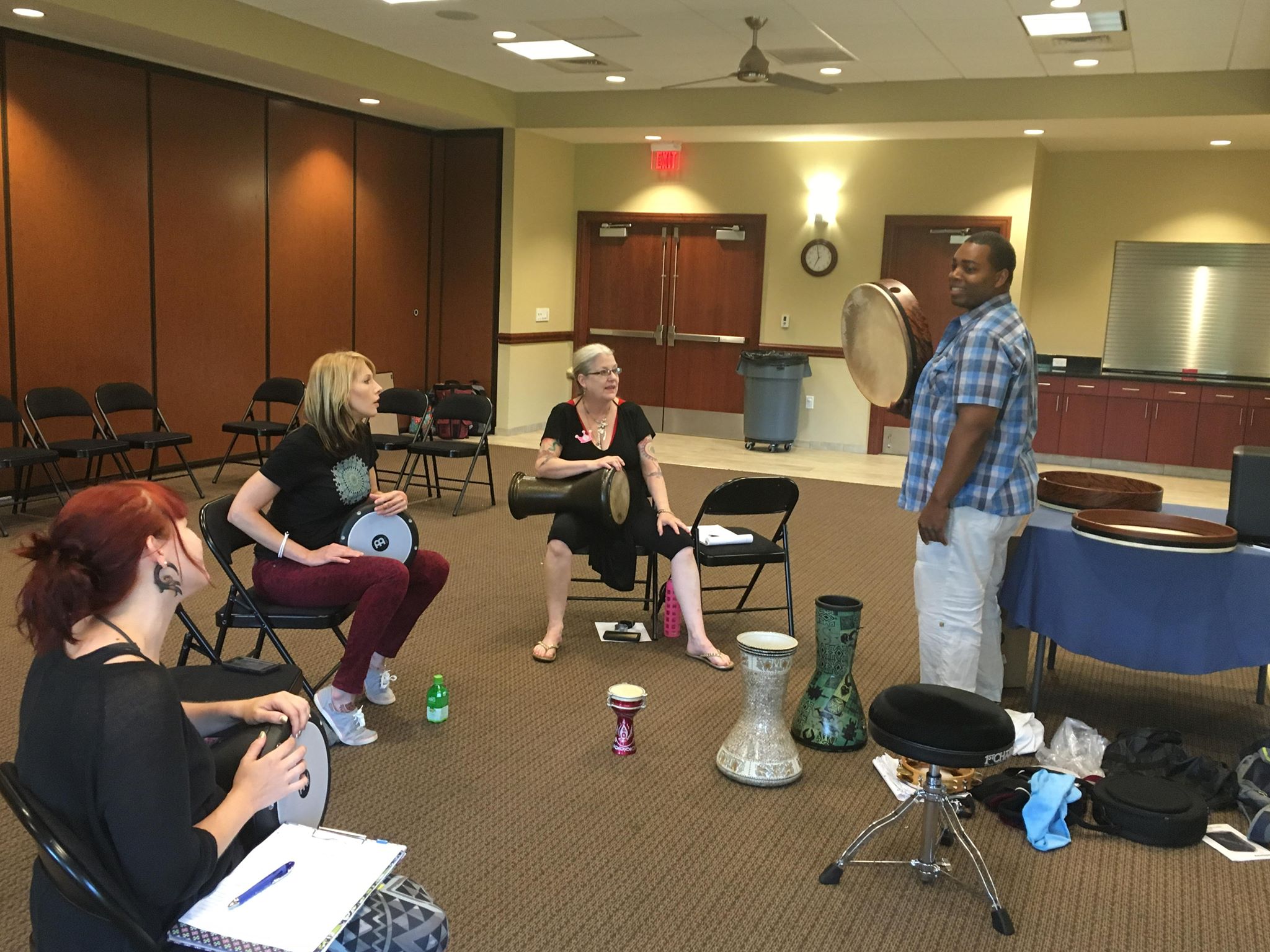
The introduction to middle eastern percussion and the improvisation classes went great! We went over the techniques and the meanings given to the sounds by the Nubians and Egyptians. We also talked about how to improvise and work with a dancer in the Arabic style, We talked about Zaar music and also introduced improvisation in the Indian style using Konnakol which is seen from many great players of the Turkish style..
This update features some of what we worked on and is mainly a supplement for the students to keep the techniques and ideas fresh in their heads and to take them farther along.
The 4 main sounds that we worked on were Dum, Tek, Ka and Pa better known as a "grab" of "slap" type stroke.
Please note that this is setup for right handed drummers. If you are a lefty, just switch the side wording (right to left) to suit your natural strong side.
Dum is usually played with the right hand at the 3 o' clock position with the hand flat, fingers closed and the thumb open and placed outside of the head and rim. Be sure that your finger tips are at or near the center of the drum and allow the hand to bounce off of the head to create a full low pitched "bass" sound.
Tek for darbuka is played with middle and ring finger together from the right hand. The index and pinky should be apart as not to hit the head or skin of the drum. To make the proper sound, hit at the edge of the drum head where the edge meets the rim to create a sharp high pitched sound.
Ka is player with the left hand ring finger. Start by placing you hand at the 12 o' clock position and rotate your hand slightly counter clockwise until the top of your ring finger meets the edge of the head. Lift your left arm and raise your hand. When you allow it to fall down, your wrist lands on the body of the drum (softly) and your ring fingers continues on the strike the edge of the head at the finger tip to create a high pitched sharp sound.
Pa is played with the right hand and all 4 fingers together. The middle of your hand should be near the edge of the head and the tips of your fingers should be at or near the center of the hear. The hand is not flat but slightly cupped (a tiny house shape) and your fingers should be very relaxed without any tension. Remember, for beginners, making the "slap" sound is not so important. When it comes to Pa strokes, focus more on grabbing and muting the head.
Here are some exercises to work on those strokes. By concentrating more on our hand/finger shapes and positions and a little less on intricate rhythms, we can learn to create the proper sounds.
This exercise counts up and each line should be repeated 4 times. After you have become comfortable with playing every line, you should play it in whole going line to line but again, repeating every line 4 times.
DT
1 2
DTK
1 2 3
DTKT
1 2 3 4
DTKTK
1 2 3 4 5
DTKTKT
1 2 3 4 5 6
DTKTKTK
1 2 3 4 5 6 7
DTKTKTKT
1 2 3 4 5 6 7 8
1 2
DTK
1 2 3
DTKT
1 2 3 4
DTKTK
1 2 3 4 5
DTKTKT
1 2 3 4 5 6
DTKTKTK
1 2 3 4 5 6 7
DTKTKTKT
1 2 3 4 5 6 7 8
Now you can substitute the T stroke with a Pa stroke to focus on that sound.
Here are some links to work on many Arabic, Persian and Turkish belly dance rhythms and their many variations.
Please remember that this music was originally taught orally and many of them have a very particular feel that may breathe here or there so you will usually see these letters in the place of musical notation to represent the different sounds and the hash mark will represent a space or rest.
Jas's Middle Eastern Rhythms
More Middle Eastern Rhythms

Here are some links to work on many Arabic, Persian and Turkish belly dance rhythms and their many variations.
Please remember that this music was originally taught orally and many of them have a very particular feel that may breathe here or there so you will usually see these letters in the place of musical notation to represent the different sounds and the hash mark will represent a space or rest.
Jas's Middle Eastern Rhythms
More Middle Eastern Rhythms

Taken at the Middle Eastern Percussion Workshop for the Dance for The Heart belly dance convention 2016
 Performing with Johanna Zenobia at the belly dance gala event
Performing with Johanna Zenobia at the belly dance gala event
The next edition of this blog will include some video of the most popular rhythms for mainly Egyptian classical and folkloric belly dance.
Stay tuned!!!!!!!!
 Performing with Johanna Zenobia at the belly dance gala event
Performing with Johanna Zenobia at the belly dance gala eventThe next edition of this blog will include some video of the most popular rhythms for mainly Egyptian classical and folkloric belly dance.
Stay tuned!!!!!!!!
